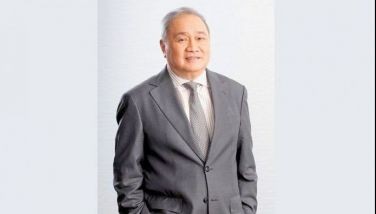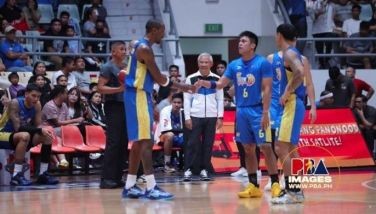BU marine protection project helps increase catch
March 17, 2002 | 12:00am
The recently awarded "Second Best Managed Reef" project of Bicol University and the local government unit (LGU) of Tabaco City has started to benefit coastal folks in the adjacent villages after their fish-catch volumes have phenomenally increased by five to eight times compared to their catches prior to the establishment of the Bicol’s first real marine-life breeding sanctuary.
Prof. Victor Soliman, a BU-Tobaco campus-based researcher who is also the project leader, said residents in the area informed him of the "good news" during the initial "impact evaluation survey" his group conducted recently. The project that has been awarded as the "Second Best Managed Reef" nationwide for 2001-2002 occupies a two-square kilometer area in Barangay Sagurong, San Miguel Island in Tabaco City.
Soliman said the higher "yields" were noted in the adjacent and nearby areas of San Miguel Island, whose fishing grounds had been already destroyed by rampant dynamite-blasting and other illegal fishing activities.
He attributed the increase in the marine life population, though in still a very short "preservation period," to the all-out support being extended by the residents and officials of Barangay Sagurong to really preserve the declared sanctuary.
"Without the support of these residents, the project implementation would not be as successful as it is now," Soliman said.
Implementors of the project dubbed "San Miguel Island Marine Fishery Reserve" started the protection and conservation activities in 1998, or shortly after the declaration of the area as a "marine fishery reserve" by the LGU of now Tabaco City.
To cushion the impact of the "no fishing policy" inside the "preserved" marine sanctuary, the San Miguel Island Marine Fishery Reserve Management Council (SMIFRMC), acting as the project’s administrative body, had sourced out financial assistance amounting to P500,000 for the affected or displaced fisherfolks in the island.
SMIFRMC was able to secure the loan from the group called Area Development Team I (ADT-1), an organization of mayors, vice mayors and other local government unit (LGU) officials in the first district of Albay.
The money was used to buy fishing gears, such as ring-nets locally known as "kalansisi" that will enable them to venture into "open sea" fishing which means catching fish and other marine lives several kilometers away from the shorelines, thus sparing the coral reefs from possible destruction.
Soliman said that only P300,000 of the half-million-peso assistance is subject to a very minimal three percent (three percent) interest every year. The balance of P200,000 is interest-free.
BU president Emiliano Aberim told The STAR that he has ordered all-out support to the said project being one of the BU projects on Bicol fish bio-diversity that also includes saving of the Philippines’ smallest fish "sinarapan" that is now facing total extinction in Lake Buhi in Camarines Sur.
Prof. Victor Soliman, a BU-Tobaco campus-based researcher who is also the project leader, said residents in the area informed him of the "good news" during the initial "impact evaluation survey" his group conducted recently. The project that has been awarded as the "Second Best Managed Reef" nationwide for 2001-2002 occupies a two-square kilometer area in Barangay Sagurong, San Miguel Island in Tabaco City.
Soliman said the higher "yields" were noted in the adjacent and nearby areas of San Miguel Island, whose fishing grounds had been already destroyed by rampant dynamite-blasting and other illegal fishing activities.
He attributed the increase in the marine life population, though in still a very short "preservation period," to the all-out support being extended by the residents and officials of Barangay Sagurong to really preserve the declared sanctuary.
"Without the support of these residents, the project implementation would not be as successful as it is now," Soliman said.
Implementors of the project dubbed "San Miguel Island Marine Fishery Reserve" started the protection and conservation activities in 1998, or shortly after the declaration of the area as a "marine fishery reserve" by the LGU of now Tabaco City.
To cushion the impact of the "no fishing policy" inside the "preserved" marine sanctuary, the San Miguel Island Marine Fishery Reserve Management Council (SMIFRMC), acting as the project’s administrative body, had sourced out financial assistance amounting to P500,000 for the affected or displaced fisherfolks in the island.
SMIFRMC was able to secure the loan from the group called Area Development Team I (ADT-1), an organization of mayors, vice mayors and other local government unit (LGU) officials in the first district of Albay.
The money was used to buy fishing gears, such as ring-nets locally known as "kalansisi" that will enable them to venture into "open sea" fishing which means catching fish and other marine lives several kilometers away from the shorelines, thus sparing the coral reefs from possible destruction.
Soliman said that only P300,000 of the half-million-peso assistance is subject to a very minimal three percent (three percent) interest every year. The balance of P200,000 is interest-free.
BU president Emiliano Aberim told The STAR that he has ordered all-out support to the said project being one of the BU projects on Bicol fish bio-diversity that also includes saving of the Philippines’ smallest fish "sinarapan" that is now facing total extinction in Lake Buhi in Camarines Sur.
BrandSpace Articles
<
>
- Latest
Latest
Latest
May 14, 2024 - 3:43pm
By Ian Laqui | May 14, 2024 - 3:43pm
April 10, 2024 - 5:12pm
By Ian Laqui | April 10, 2024 - 5:12pm
March 4, 2024 - 3:32pm
By Ian Laqui | March 4, 2024 - 3:32pm
March 4, 2024 - 2:12pm
By Kristine Daguno-Bersamina | March 4, 2024 - 2:12pm
February 17, 2024 - 2:31pm
February 17, 2024 - 2:31pm
Recommended




























